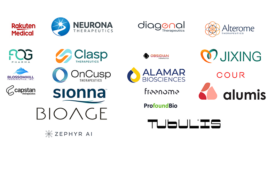
Hollings Cancer Center (HCC) researcher Besim Ogretmen, is program coleader of Hollings Cancer Center’s Developmental Cancer Therapeutics Research Program, and professor of Biochemistry and Molecular Biology at MUSC Hollings Cancer Center at the Medical University of South Carolina. Credit: Brennan Wesley
Normal cells have a complex system of checks and balances that regulate cell division. In cancer, the balance is tipped in favor of cell proliferation. This imbalance arises from increased levels or activity of oncoproteins (proteins that promote cell growth) or decreased levels or activity of tumor suppressors (proteins that limit cell growth). For example, in normal cells, the tumor suppressor protein phosphatase 2 (PP2A) controls cell growth, migration and immortalization to keep cells in check. Some cancers, such as lung cancer, have higher levels of an oncoprotein with the unwieldy moniker su(var)3-9, enhancer of zeste, trithorax (SET). SET binds PP2A and inhibits the normal function of PP2A, resulting in loss of the checkpoint for cancer growth.
Researchers at the Medical University of South Carolina (MUSC) who study lipid signaling in the context of cancer biology have examined the molecular details of the relationship between SET and PP2A and how the sphingolipid ceramide, a ubiquitous component of cell membranes and important signaling lipid, interacts with SET to regulate its function. Their results, published online on March 27, 2019 by The FASEB Journal, identified a specific nook in the SET protein’s shape that provides a snug fit for ceramide, which results in the release of SET from PP2A and restores PP2A’s growth-suppressive function.
“This was the first time we used structural biology techniques to understand how lipids bind proteins,” Besim Ogretmen, senior author for this study, Hollings Cancer Center (HCC) researcher, program coleader of HCC’s Developmental Cancer Therapeutics Research Program, and professor of Biochemistry and Molecular Biology at MUSC, said.
The shape of the ceramide-SET interface was difficult to determine using X-ray crystallography, so Ogretmen and his team worked with the nuclear magnetic resonance (NMR) core facility at MUSC to overcome this hurdle. This work identified critical amino acids within the SET protein that contacted ceramide, resulting in the identification of a lipid-binding pocket. Further studies showed that an FDA approved immunosuppressive drug, fingolimod (a sphingolipid analog, known as FTY720), also bound this lipid-binding pocket.
This structural analysis represents a key step forward in the path to precision cancer treatment.
“Using an NMR-guided study, you can understand how to actually target an oncoprotein,” Ogretmen said. “Following up those studies, you can also understand how targeting an oncoprotein leads to cell death.”
This led Ogretmen to look at SET’s interaction with PP2A. PP2A is a complex enzyme that consists of three components, each of which have multiple isoforms. This means that hundreds of different combinations of PP2A can exist within the same cell. Often, it has been assumed that all PP2A isoforms act the same way or that they are redundant.
Interestingly, this study revealed that PP2A is even more complex than previously thought.
“We learned that there is a specific sub-type of PP2A which is targeted by the SET oncoprotein,” Ogretmen said. “When we relieve this oncoprotein from PP2A, by ceramide or fingolimod, we see there is a specific isoform of PP2A that is activated.”
In cancer cells, SET binds a specific PP2A isoform and inhibits PP2A’s tumor suppressor function. Binding of fingolimod to SET prevents SET from binding PP2A, allowing PP2A to be active and kill cancer cells. While there are many isoforms of PP2A, Ogretmen thinks that the isoform that his group identified might be selectively regulated by SET, which then may regulate the other PP2A isoforms.
In summary, this study provides a detailed understanding of how molecules see and associate with their targets, and these structural details provide a platform for future drug development. To that end, Ogretmen and his team are using structure-based modeling and rational drug design to develop inhibitors that mimic fingolimod and can bind the lipid-binding pocket on SET. Furthermore, they have begun to screen a library of FDA-approved, already existing drugs that have mechanisms of action similar to that of fingolimod without immune suppression. The advantage of this approach is that the drugs have already proved to be safe for human use, which would shorten the time to clinical use. These two approaches have identified several lead candidate compounds and may provide the basis for the development of inhibitors that restore cell growth checkpoints in cancer cells.
Filed Under: Oncology




